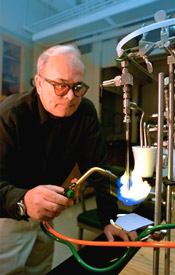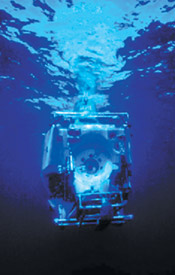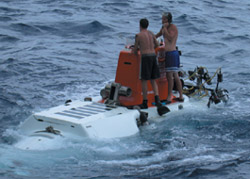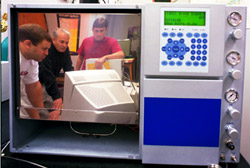Caves, Ocean Floor Give Geologists Weather Reports from Thousands of Years Ago
by Chris Bryant

Dr. Paul Aharon regularly travels to two of the darkest places on the planet in an effort to shed light on the global warming debate.
The ocean’s floor and the heart of a cave are two of the few places where you can experience a complete absence of light, and Aharon, a University of Alabama professor of geology and holder of the Ray E. Loper Endowed Chair in Geological Sciences, has spent much time in both locations.
On some 50 occasions since 1989, he’s been part of selective research teams that have dived to the ocean’s innermost depths — in the Gulf of Mexico and the North Atlantic Ocean. Inside submersibles, or small submarines, Aharon has traveled as deep as 7,000 feet during research dives that take as long as nine hours each.
“Navigating the ocean’s floor is like being in the desert,” Aharon said, “you don’t have any bearings there. You have to try and use your sense of direction and your experience to find a specific target.”
At the low temperatures and high pressures typically found on the ocean’s floor, these frozen mixtures are stable. However, if future global warming leads to higher ocean temperatures, more methane could be released from the gas hydrates into the water and up to the atmosphere, where it may act as a highly potent greenhouse gas and alter the global climate in an unprecedented way, the UA geologist said.
Aharon has often been granted time to use the submersible ALVIN, best known for its use in the discovery of the Titanic, for his dives. The sub, large enough only for a pilot and two scientists, is also equipped with a robotic arm. With the help of the robotic arm, the sub’s lights, and its ability to cruise along the ocean’s seabed, Aharon directs the pilot to retrieve specific cores of sediment from the seabed.
Despite the seriousness and the technical nature of the science involved, Aharon said he still gets caught up in the beauty and wonder of the ocean life that surrounds him.

“I turn off all the lights,” Aharon said of his descents to the bottom of the ocean. “You can see all sorts of critters with unbelievable colors. It’s a terrific feeling.”
After obtaining the sediment cores, and then conducting various analyses, Aharon documents the presence of certain chemical markers. Later, Aharon compares those chemical markers with markers taken from other core samples and can often determine locations in the seabed where gas hydrates were once present but are not any longer.
These “missing” gas hydrates are indicators of previous occasions when different oceanic conditions existed and the methane, perhaps in large quantities, was released from the hydrates into the ocean and then into the atmosphere. Scientists are interested in pinpointing when conditions differed and how the methane was released. Locating clues related to the earth’s climate at the time the methane was released gives the researchers insight as to the likelihood of similar occurrences in the future.
Aharon’s exploration work on the ocean’s floor has been funded by grants from NOAA/NURP (National Oceanic and Atmospheric Administration/National Undersea Program) and the Department of the Interior/Mineral Management Service — at the rate of $25,000 per day of the dive.
Just as the ocean’s floor contains hidden secrets about the world’s unstable climate, so too do the gloomy chambers inside caves. These ancient weather archives aren’t found written in some cryptic man-made carvings on the cave’s prehistoric walls, although they can be as difficult to decipher as if they were. Instead, these clues are found inside various cave deposits, known as speleothems, within the caves’ confines. These speleothems, including the stalagmites and stalactites that are popular and readily visible to cave tourists, are up to hundreds of thousands of years old, Aharon said.
“They can serve as an archive of environmental conditions at a particular time,” Aharon said of the cave deposits. They form when rainfall passes through soil and carbonate bedrock and enters the cave.
Aharon and Michael Rasbury, a UA geological sciences graduate student, spent three weeks in July collecting samples of cave deposits from the Polynesian island of Niue. Located just to the east of Fiji, and some 2,400 km northeast of New Zealand, Niue (pronounced new-ay) is home to approximately 1,700 people and a wealth of caves, many of which had never previously been explored by scientists. It’s a carbonate island, meaning it is comprised of coral reef build-up, and, at 259 square kilometers, is said to be one of the world’s largest carbonate islands.
The major factor in climatic changes worldwide is El Nino. “It originates in the Pacific and controls the global climate at present,” Aharon said. Although only in recent years has the term been introduced to the general public’s vernacular, it’s a term that has been used since the late 1800s. It refers to a temporary change in the Pacific Ocean’s climate, specifically the area of the ocean near the equator. Warming of the ocean by a few degrees, a movement in heavy thunderstorms and shifts in the air pressure along an area near the equator are all associated with El Nino.
The UA researchers hope to develop more information about the effects El Nino has had on weather patterns throughout time. “We propose that El Nino was a dominant force of change in the past as well as in the present,” Aharon said. Gaining evidence as to whether it was or wasn’t can influence global warming arguments. “These studies could allow us to disentangle the natural climate variability from man-made effects,” said Rasbury, a Sulligent native.
The researchers said there are many things about caves, and about the weather patterns of this particular isolated island location, that help researchers in understanding past climatic changes. “This island is not getting the effect of the continent but is getting the full effect of El Nino,” Aharon said. Typical seasonal temperature variations do not impact the cave’s temperature, the researchers said. “The cave’s temperature is the same year round,” Rasbury said. “It’s equal to the average yearly surface temperature,” the graduate student said. “The entire region has to change its climate for the cave’s temperature to fluctuate,” Aharon said. So, pinpointing the temperature in a cave at a particular moment in time enables researchers to know much about the region’s temperatures during that same period.

After responsibly removing samples of the cave’s speleothems and returning them to the laboratory, Aharon and Rasbury can learn much about the climate conditions when these cave deposits formed by measuring the stable isotopes of oxygen and carbon present in the samples. (Isotopes are atoms of the same element that have the same number of protons but a different number of neutrons.) “The speleothems are a direct function of precipitation, cave temperature and drip water chemistry,” Rasbury said, and can reveal much about the rainfall and air temperature in the past. Rainfall, as an example, has its own, specific isotopic signature. Other isotopes, of the radioactive kind, can provide clues as to the time frame the sample reflects.
Since scientists know, for example, how long it takes a particular parent radioactive isotope to decay into a “daughter” isotope, measuring the parent/daughter isotopes and knowing the decay rate — which occurs incredibly slowly over thousands of years — tells them how old the object is. Further analyses using carbon and nitrogen isotopes found in the stalagmites can give the researchers clues as what type of vegetation was present during the periods when particular parts of the speleothems formed. And since much plant life can only exist within a narrow range of temperature and rainfall conditions, indications of a particular plant’s presence also give weatherrelated clues. “In this way, we use the modern environment as an analog to the past,” Aharon said.

The UA researchers’ project is funded by a National Science Foundation grant awarded to Aharon over a two-year period.
As exhilarating as the caving expedition was, the researchers noted that actually getting to the remote island was an adventure in itself. The pair flew from Birmingham to Atlanta and then to Los Angeles. From Los Angeles, they boarded an Air New Zealand flight to Apia, Western Samoa, and then to the island of Nuku-Alofa, the main island of Tonga Archipelago. They then boarded Royal Tongan Airline in Tonga for one of its twice-a-week flights to Niue.
The trip was also expected to provide Rasbury, who had not previously traveled outside the United States, with a little summer island fund. “Humpback whales are going to be migrating while we are there,” Rasbury said, shortly before leaving on the trip, “and I’m probably going to go snorkeling while I’m there.”

Learning more about previous El Nino occurrences can give researchers insight into whether the planet’s recent temperature elevations are just part of the natural cycle or whether they are a result of man-made activities that are changing the environment, Aharon said. This could free up the current gridlock resulting from the uncertainties surrounding the global warming debate. “As long as things are uncertain, nobody is doing anything,” he said.
Contact
Chris Bryant, Assistant Director of Media Relations, 205/348-8323, cbryant@ur.ua.edu
Source
Dr. Jim Knight, 205/348-9926, vknight@as.ua.edu
